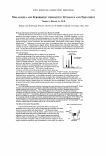104 JOURNAL OF COSMETIC SCIENCE generally proportional to the amount of sebum production (1,13). For the absorptive characteristic of Acne Dressing®, this kind of material has shown efficacy in many skin conditions, and is an effective way to absorb sebum production and reduce the oiliness of the skin. The ratio of transmission in Acne Dressing® during the period of UVB exposure (280 nm-320 nm) is less than 7.4%, which is helpful in reducing the damage from sunlight. Significant efficacy in reducing red pigmentation has been shown during treatment however, this is not to say that dark pigmentation will not present itself again in the future. Long-term observation and long-term treatment with Acne Dressing® is to be considered for further study. No studies have ever tried to use Acne Dressing® to treat acne. Therefore, the result of this study is compared with those of similar studies. To our knowledge, this is the first randomized study showing that an Acne Dressing® can produce effects and clinical improvement after exceedingly short periods of skin contact. A possible explanation for the efficacy of short-contact therapy may be found in the Lichen amyloidosus study of Hallel-Halevy and colleagues (8). Their work demonstrated that hydrocolloid dressings achieve an excellent effect in the skin of Lichen amyloidosus after tape periods as short as one day. Successive application of Acne Dressing® gives a dramatic effect in active acne over a short period of time. This result fits in with Webster's suggestion of treating acne: "Treatment regimens should be simple" (14). In addition, Acne Dressing® is self- adhesive and can be left on the skin for two days or more. This kind of tape is waterproof, thus permitting face washing, and is protective in addition to being cosmetically ac- ceptable. Moreover, the circular and thin formulary form and skin color tapes not only cover the redness to improve the cosmetic outcome, but also allow ventilation, which in turn leads to no increase in the level of inflammation. Based on this pilot study, it may be an evident that Acne Dressing® is a new option by itself or in conjunction with oral antibiotics for treating acne, and can result in im- provement in mildly and moderately inflamed papules. Despite much interest and a rigorous prospective, randomized and controlled trials in this area are limited. In order to establish its recognition, more clinical studies are needed to elucidate the treatment's efficacy in different acne symptoms in a large set of patients and in longer followup periods. ACHNOWLEDGMENT We thank Mr. Edison Chen, who provided the material for study. As research assistant, he assisted with data entry, data analysis, and the production of the figures and tables. REFERENCES (1) U. Jappe, Pathological mechanisms of acne with special emphasis on Propionibacterium acnes and related therapy, Acta Denn. Venereal., 83, 241-248 (2003). (2) H. Gollnick, Current concepts of the pathogenesis of acne: Implications for drug treatment, Drugs, 63, 1579-1596 (2003). (3) S. K. Brown and A. R. Shalita, Acne vulgaris, Lancet, 351, 1871-1876 (1998).
EFFICACY TREATMENT OF ACNE VULGARIS 105 (4) P. E. Pochi and J. S. Strauss, Endocrinologic control of the development and activity of the human sebaceous gland. J. Invest. Dermatol., 43, 383-388 (1964). (5) M. Gfesser and W. I. Worret, Seasonal variations in the severity of acne vulgaris, Int. J. Dermatol., 35, 116-117 (1996). (6) N. Hjotth, K. E. Sjolin, B. Sylvest, and K. Thomsen, Acne aestivalis-Mallorca acne, Acta Der1n. Venereol., 52, 61-63 (1972). (7) I. M. J. J. van Vlijmen-Willems, A. Chang, J.B. Boezeman, and P. C. van de Kerkhof, The immu- nohistochemical effect of a hydrocolloid occlusive dressing (DuoDERM E) in psoriasis vulgaris, Der- matology, 187, 257-262 (1993). (8) D. Hallel-Halevy, E. Finklstein, M. H. Grunwald, and S. Halevy, Lichen amyloidosus treated by hydrocolloid dressing,JEADV, 18, 691-692 (2004). (9) J.E. Zeegelaar, W. Langenberg, R. Hu, F. M. Lai, A. Fat, and W.R. Faber, Tolerability and efficacy of hydrocolloid dressings in the treatment of venous leg ulcers under tropical conditions: An open prospective study,]. Eur. Acad. Dermatol. Venereol., 15, 234-237 (2001). (10) S. J. Orringer, S. Kang, T. Hamilton, W. Schumacher, S. Cho, C. Hammerberg, J. G. Fisher, J. D. Karimpour, M. T. Johnson, and J. J. Voorhees, Treatment of acne vulgaris with a pulsed dye laser, JAMA, 291, 2834-2839 (2004). (11) J. Cunliffe, Acne (Martin Dunitz Ltd, London, 1997). (12) M. M. S. Mulder, V. Sigurdsson, E. J. van Zurren, E. J. Klaassen, J. A. J. Faber, J.B. F. de Wit, and W. A. van Vloten, Psychosocial impact of acne vulgaris, Dermatology, 203, 124-130 (2001). (13) P. Mondon, K. Lintner, F. Girard, and C. Gibaud, The effect of a synthetic ceramide-2 on transepi- dermal water loss after stripping or sodium lauryl sulfate treatment: An in vivo study, Int. J. Cosmet. Sci., 19, 15-25 (1997). (14) G. Y. Webster, Acne vulgaris, BM], 325, 475-478 (2002).
Purchased for the exclusive use of nofirst nolast (unknown) From: SCC Media Library & Resource Center (library.scconline.org)










































































































